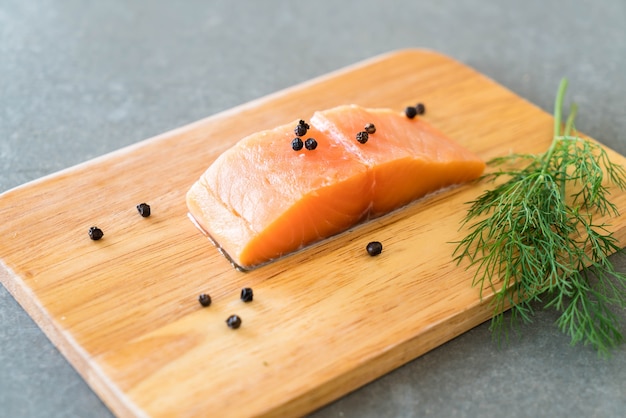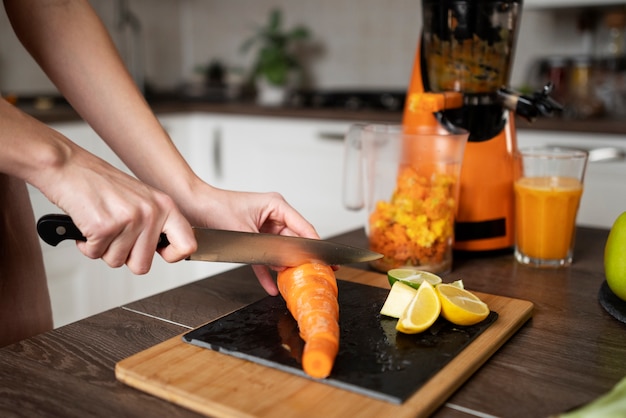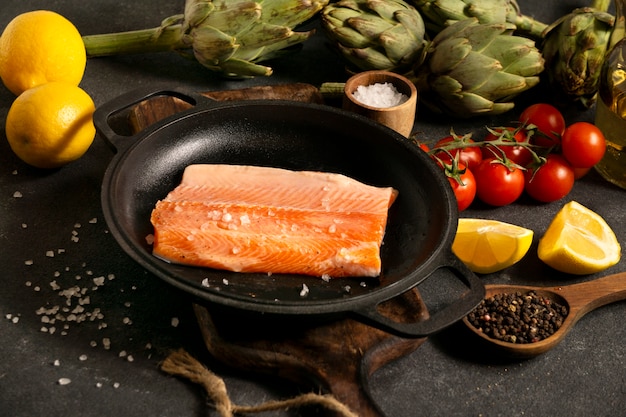I'll confess, there's something truly magical about cedar plank salmon. The scent of smoky cedarwood, the anticipation of that first juicy bite – it’s a culinary experience that always brings a smile to my face. But let's be honest, sometimes the thought of tackling a new cooking technique can be a bit daunting. So, grab a cuppa, settle in, and let me walk you through the world of cedar plank salmon, from choosing the perfect plank to achieving that perfectly smoky char. We'll explore everything you need to know, with personal tips and tricks to make this delicious dish a regular feature on your dinner table.
Part 1: Unveiling the Magic of Cedar Plank Salmon

Why Cedar Plank? The Enchanting Flavor Journey
Remember that first time you tasted cedar plank salmon? The succulent, flaky fish, infused with that woodsy smokiness – it was a revelation, wasn't it? It's not just about the flavor, though. Cedar plank cooking adds a whole new dimension to salmon, bringing out its natural sweetness and creating a truly unforgettable dining experience. It's like a symphony of flavours, each note playing its part to create a harmonious masterpiece.
The Science Behind the Sizzle
What makes this cooking method so special? It's all about the interplay of heat, moisture, and flavour. The cedar plank acts like a natural conductor, evenly distributing heat to the salmon while also adding moisture, ensuring it cooks to perfection. But the real magic happens when the wood imparts its unique smoky flavour, infusing the salmon with a delightful aroma and taste. It's a simple yet elegant process that allows the natural flavour of the salmon to shine through.
Part 2: Choosing Your Cedar Plank: A Foundation for Flavor

The Wood: It's Not Just Any Cedar
Choosing the right cedar plank is crucial for achieving that perfect smoky flavour. It’s like selecting the perfect wine to complement your dish – the right wood can enhance the overall flavour experience. Here's a breakdown of the popular options:
- Western Red Cedar: This is the classic choice for a reason. It has a mild, sweet flavour that blends beautifully with salmon, allowing the fish to take center stage. It's versatile and readily available, making it a great starting point for beginners.
- Alaska Yellow Cedar: This cedar boasts a more pronounced, slightly pungent aroma and flavour, which can be a bit overpowering for some. It's best suited for those who enjoy bolder flavours and crave a more assertive woodsy note.
- Redwood: While this can be an option, choose redwood specifically treated for food use. Some types can be toxic. It's best to stick to the more readily available and food-safe cedar options.
Finding the Perfect Plank: What to Look For
Once you've chosen your cedar variety, it's time to find the perfect plank. Look for one that is:
- Free of knots and cracks: These can cause the plank to warp or break during cooking, leading to uneven cooking and potential safety hazards.
- Smooth and even: This ensures even heat distribution and prevents the salmon from sticking. You want a surface that allows for a consistent and even cook.
- Thick enough: A thin plank can burn too quickly, resulting in uneven cooking and potentially a burnt salmon. Aim for a plank that's thick enough to withstand the heat and allow for a gradual, even cook.
When buying pre-soaked planks, check to make sure they are still damp. Dry planks can burn easily and won't impart the same flavour as those that are properly soaked.
Part 3: Preparing the Cedar Plank: A Ritual of Flavor

The Soaking Ritual: A Crucial Step
Soaking the plank is essential for a successful cedar plank salmon experience. It prevents the wood from burning, adds moisture to the fish, and allows the cedar flavour to infuse into the plank. I've experimented with different soaking methods, but I've found that soaking in cold water for at least 30 minutes before grilling is the most effective. Some soak their planks for longer, up to a few hours, but I've found 30 minutes is generally enough.
Prepping the Plank for Salmon: Ready for the Main Event
After the soaking ritual, it's time to prep the plank. I like to give it a good scrub with a brush to remove any lingering debris. Then, I lightly oil it with a neutral oil, like grapeseed or avocado oil. This prevents sticking and ensures even cooking. You don't want the salmon to stick to the plank, so a light coating of oil is your best friend here.
Part 4: Choosing and Preparing the Salmon: The Star of the Show
The Salmon: The Essence of Flavor
Now, let's talk about the star of the show, the salmon. You want to choose a high-quality piece that's bursting with flavour. Here's what to look for:
- Freshness: Look for bright, shiny skin and firm flesh. The flesh should spring back when you press it gently. Freshness is key for delicious salmon.
- Size and Thickness: For cedar plank cooking, I prefer a thick cut of salmon, about 1-1.5 inches thick. This ensures a nice, juicy center and allows the smoky flavour to penetrate deeper. Thick cuts are the way to go for cedar plank cooking.
- Wild-Caught vs. Farmed: This is a personal preference, but I tend to favour wild-caught salmon. It often has a more intense flavour and a higher fat content, which makes it incredibly flavourful. Ultimately, it's about choosing what you prefer!
Simple Seasoning: Enhancing Natural Flavors
The beauty of cedar plank salmon lies in its simplicity. You don't need a million different ingredients to make it delicious. Just a few basic seasonings will enhance the natural flavour of the salmon. My go-to is salt, pepper, and a squeeze of lemon juice. The salt and pepper bring out the natural flavour of the salmon, while the lemon adds a bright, tangy touch. Some people like to add herbs like dill, thyme, or rosemary, but I find that these can sometimes overpower the delicate taste of the cedarwood smoke.
For a bit of extra flavour, I sometimes add a drizzle of olive oil or a pat of butter to the salmon before cooking. The fat helps to keep the salmon moist and tender. A touch of fat never hurts!
Part 5: Cooking the Salmon: Mastering the Technique
The Grilling Technique: Indirect Heat is Key
Here's where things get exciting! The key to perfectly cooked cedar plank salmon is to grill over indirect heat. This means the heat source should be off to the side, not directly below the salmon. This allows the salmon to cook evenly and prevents it from burning. If you’re using a gas grill, turn on just one burner or use a grill pan set over the flame. For charcoal grills, build the coals on one side of the grill.
Heat Levels and Timing: A Gradual Cook
The ideal temperature for grilling cedar plank salmon is around 350°F (175°C). However, you'll need to adjust the temperature based on the thickness of your salmon. Start by preheating the grill with the cedar plank resting on the grates. Once the plank is hot, carefully place the seasoned salmon on top. Close the lid and allow the salmon to cook for about 15-20 minutes, or until the internal temperature reaches 145°F (63°C).
Remember, it's important to check the internal temperature of the salmon using a meat thermometer. You don't want to overcook it, as that will make it dry and tough. A thermometer is your best friend here!
The Finishing Touch: Patience is a Virtue
When the salmon is cooked to your liking, carefully remove the plank from the grill and let it rest for a few minutes before serving. This allows the juices to redistribute, ensuring a more tender and flavorful salmon. Patience is key here, as the salmon will continue to cook slightly as it rests.
Part 6: Serving and Enjoying Cedar Plank Salmon: A Culinary Symphony
Presentation: A Visual Feast
Cedar plank salmon is a showstopper, visually appealing and deliciously satisfying. It looks beautiful served on the plank, surrounded by your favourite sides. I love to serve it with a medley of grilled vegetables, like asparagus, zucchini, and bell peppers. A side of creamy mashed potatoes or a simple salad also pairs well. Don't forget to squeeze a bit of fresh lemon juice over the salmon before serving. It adds a bright and tangy touch to the smoky flavour.
The Flavor Symphony: A Multi-Sensory Experience
When you take your first bite of cedar plank salmon, you'll be greeted by a symphony of flavours. The smoky char from the cedarwood will tantalize your taste buds. The salmon will be tender and flaky, with a delicate sweetness. And the aroma of the wood smoke will fill the air, creating a truly magical dining experience.
Part 7: Beyond the Grill: Oven-Baked Cedar Plank Salmon
Oven-Baked Bliss: A Grill-Free Option
Not everyone has access to a grill. But don't despair! You can still enjoy cedar plank salmon in the oven. Preheat your oven to 400°F (200°C). Place the prepared plank, with the salmon on top, on a baking sheet. Bake for 15-20 minutes, or until the salmon is cooked through. Oven-baked cedar plank salmon is just as delicious and perfect for those without a grill.
Part 8: Tips and Tricks: Mastering the Art of Cedar Plank Salmon
Elevating Your Cedar Plank Game
Here are a few tips and tricks to elevate your cedar plank salmon game:
- Use a thermometer: Always check the internal temperature of the salmon to ensure it's cooked through. A thermometer is an essential tool for ensuring perfectly cooked salmon.
- Don't overcook: overcooked salmon will be dry and tough. A little patience goes a long way!
- Don't let the plank dry out: Keep the plank moist by spraying it with water occasionally during cooking. This helps prevent the plank from burning and ensures a smooth cook.
- Experiment with flavours: Try different herbs and spices to create your own unique flavour combinations. Get creative and have fun with your seasonings!
- Clean the plank after use: After cooking, let the plank cool completely, then wash it with soap and water. Cleanliness is key for maintaining your plank and ensuring its longevity.
Part 9: Cedar Plank Beyond Salmon: Expanding Your Culinary Horizons
Exploring New Flavour Frontiers
The beauty of cedar plank cooking isn't limited to salmon. You can also cook other types of fish, like trout, halibut, or mahi-mahi. You can even cook vegetables, like asparagus, broccoli, or mushrooms, on the plank. Just remember to adjust the cooking time based on the type of food you're using. Don't be afraid to get creative and explore new culinary horizons!
Part 10: FAQs: Addressing Common Questions
1. Can I reuse cedar planks?
It's not recommended to reuse cedar planks multiple times. The wood tends to dry out and burn more easily with each use. It's best to use a fresh plank each time for the best results.
2. Can I use other types of wood?
While cedar is the most popular choice, other woods can also be used for plank cooking, such as maple, cherry, or apple. However, make sure the wood is safe for food use. Always research the wood before using it for cooking.
3. How can I prevent the salmon from sticking to the plank?
Lightly oiling the plank before cooking will help prevent the salmon from sticking. You can also use a parchment paper liner on the plank.
4. How do I know when the salmon is cooked?
The salmon will be cooked through when the internal temperature reaches 145°F (63°C). You can also tell by the colour of the flesh – it should be opaque and flaky.
5. What can I do with the leftover plank?
Once you've finished cooking, you can use the leftover plank for smoking cheese, vegetables, or nuts. It can also be used to add a smoky flavour to sauces or soups. Don't throw away those leftover planks! They have a lot of potential for further culinary adventures.
Part 11: Embracing the Cedar Plank Experience
Cedar plank salmon is more than just a meal. It's an experience. It's the aroma of cedarwood smoke filling the air, the sizzle of the fish on the hot plank, and the anticipation of that first delicious bite. It's a celebration of fresh, simple ingredients cooked to perfection. So, embrace the cedar plank experience – you won't be disappointed.
Everyone is watching

Prime Rib Roast Cooking Time Chart: Per Pound Guide
Cooking TipsPrime rib roast. Just the name conjures images of lavish dinners, crackling fires, and hearty laughter. It’s ...

How Long to Bake Potatoes in the Oven (Perfect Every Time)
Cooking TipsBaked potatoes are a staple in my kitchen. They're incredibly versatile, delicious, and surprisingly easy to m...

Perfect Rice Every Time: The Ultimate Guide to Cooking Rice
Cooking TipsAs a self-proclaimed foodie, I've always been a bit obsessed with rice. It's the foundation of countless cuisi...

The Ultimate Guide to Cooking Asparagus: Tips, Techniques, and Recipes
Cooking TipsAsparagus. The mere mention of this spring delicacy conjures up images of vibrant green spears, crisp and burs...

Ultimate Guide to Cooking the Perfect Thanksgiving Turkey
Cooking TipsThanksgiving. Just the word conjures up images of overflowing tables laden with delicious food, the scent of r...
